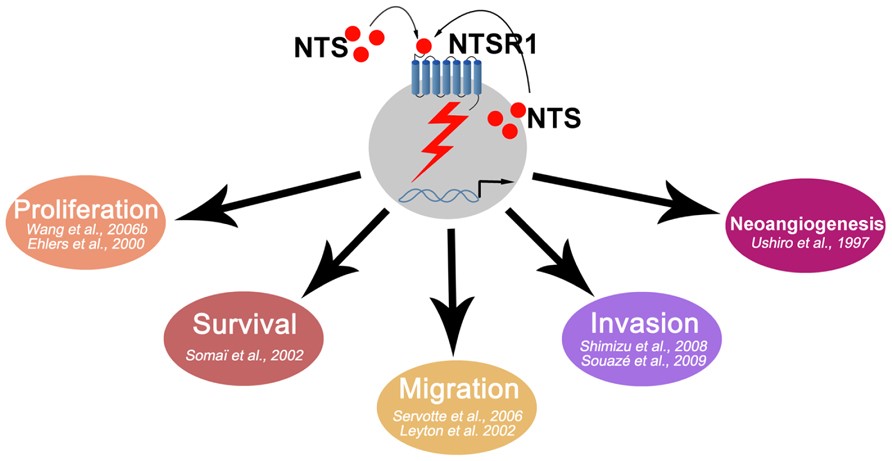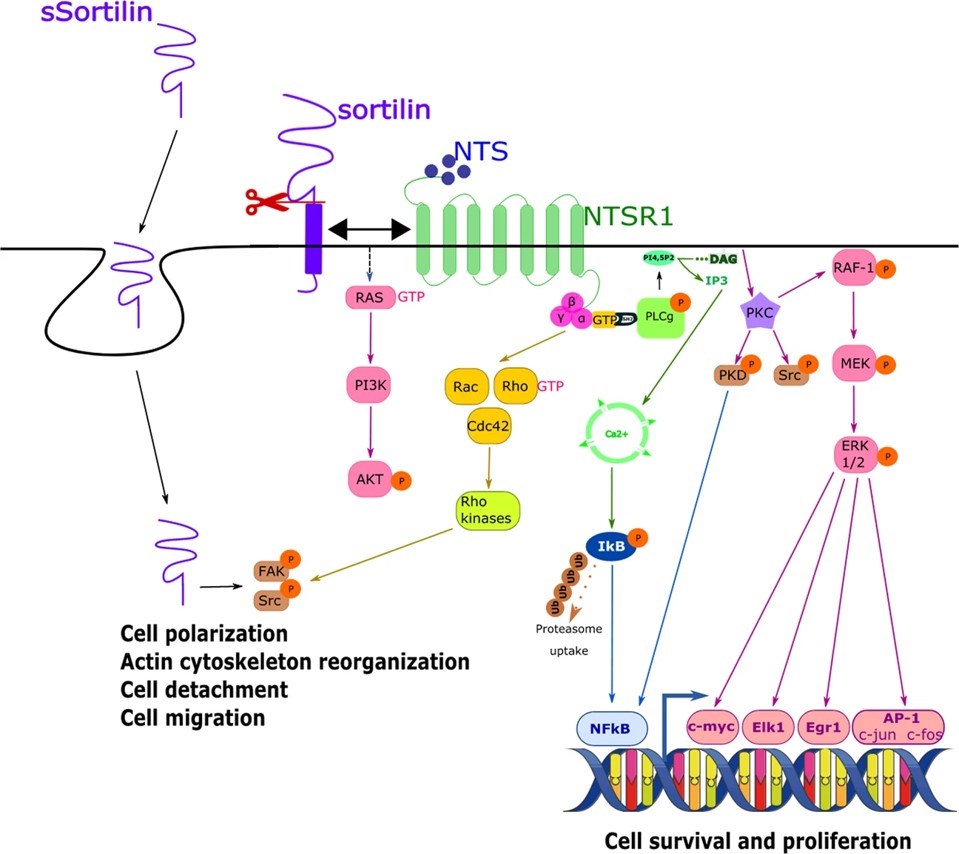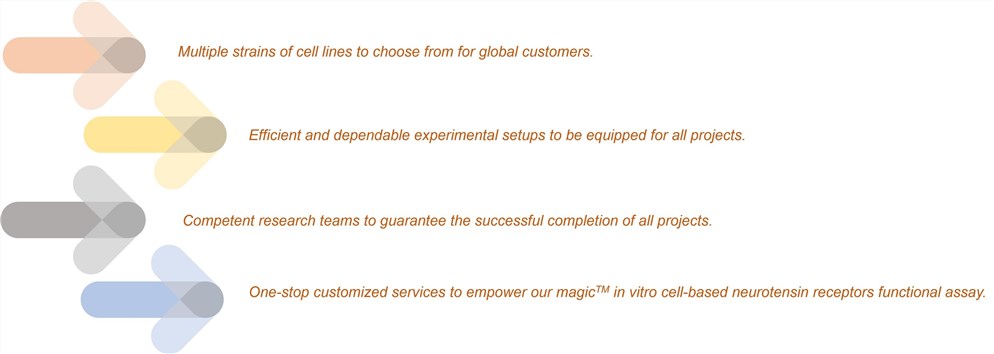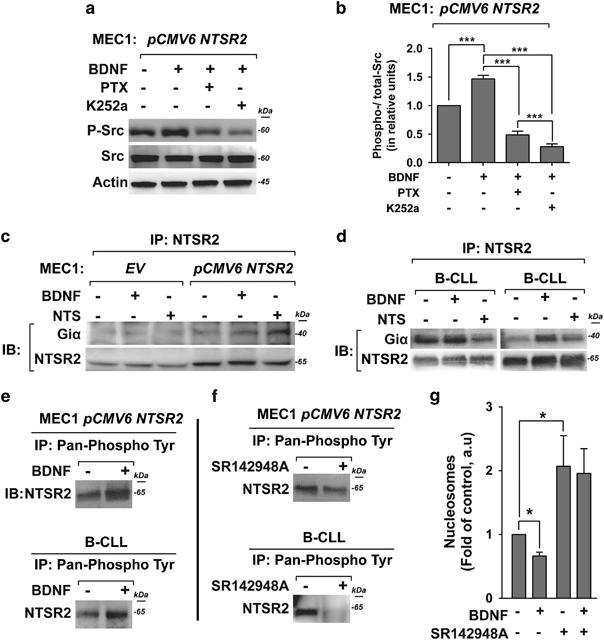Hi-Affi™ In Vitro Cell based Neurotensin Receptor Functional Assay Service
Neurotensin Receptors Overview
Neurotensin receptors are a type of transmembrane receptors responsible for transmitting the signaling of neurotensin. There are three subtypes: NTSR1, NTSR2, and NTSR3. NTSR1 and NTSR2 feature seven transmembrane helices and belong to GPCRs. The third receptor NTSR3, also called sortilin, has a single transmembrane domain. Every one of them is implicated in the development of several cancers, including prostate cancer, lung cancer, pancreatic cancer, and others. Consequently, identifying the contribution of neurotensin receptors in the underlying molecular mechanisms of distinct cancers could potentially encourage the development of drugs and the personalization of therapy.
 Fig.1 Schematic representation of NTS oncogenic effects.1
Fig.1 Schematic representation of NTS oncogenic effects.1
Our Hi-Affi™ In Vitro Cell-based Neurotensin Receptor Functional Assay Service
Innovatively, Creative Biolabs incorporates the cell-based assay with neurotensin receptors functional assay and succeeds in developing a Hi-Affi™ in vitro cell-based neurotensin receptor functional assay service featuring rapid and reliable. Cordially welcome global customers to inquire and order.
Our Hi-Affi™ in vitro cell-based neurotensin receptor functional assay service measures the calcium flux in cellular in response to the activation of G protein caused by neurotensin receptors reacting to their ligands. Accordingly, we can analyze the signaling pathway of neurotensin receptors, as well as examine candidate samples and their functions. To ensure global customers' projects run smoothly, we provide a full around of top-notch customized services.
 Fig.2 Simplified scheme of the NTS signaling pathways involving NTSR1 and sortilin, and biological effects associated.2
Fig.2 Simplified scheme of the NTS signaling pathways involving NTSR1 and sortilin, and biological effects associated.2
Advantages
Our Hi-Affi™ in vitro cell-based neurotensin receptor functional assay service breaks the limitation of conventional neurotensin receptor functional assays and has succeeded in achieving innovative developments in technology, applications, and other aspects. Simultaneously, our Hi-Affi™ in vitro cell-based neurotensin receptor functional assay service can deliver significant benefits to global customers:
 Fig.3 Advantages of our Hi-Affi™ in vitro cell-based neurotensin receptor functional assay service.
Fig.3 Advantages of our Hi-Affi™ in vitro cell-based neurotensin receptor functional assay service.
Representative Data
DATA 1: Through this investigation, the results found that neurotensin receptor 2 (NTSR2) is a critical factor in apoptosis resistance in B-CLL. While B-CLL cells and patient plasma showed high amounts of NTSR2, modest levels of its natural ligand- neurotensin (NTS) were detected. Instead of being the product of a mutation-induced gain-of-function, NTSR2's surprisingly sustaining active phosphorylation state was the result of a collaboration with the oncogenic tyrosine kinase receptor TrkB. In contrast to NTS, B-CLL cells produce high levels of brain-derived neurotrophic factor (BDNF), making the NTSR2-TrkB interaction a conditional oncogenic driver.
 Fig.4 The phosphorylation of NTSR2 in B-CLL and Giα proteins recruitment.3
Fig.4 The phosphorylation of NTSR2 in B-CLL and Giα proteins recruitment.3
Work with Creative Biolabs
Constantly, in response to customers' feedback, Creative Biolabs is committed to developing and innovating technological innovations. If you are interested in our Hi-Affi™ in vitro cell-based neurotensin receptor functional assay service, please feel free to contact us.
References
-
Martinez-Fong, Daniel, Jean Trédaniel, and Patricia Forgez. "Neurotensin and its high affinity receptor 1 as a potential pharmacological target in cancer therapy." Frontiers in endocrinology 3 (2013): 39278.
Distributed under Open Access License CC BY 3.0, without modification. -
Christou, Niki, et al. "Neurotensin pathway in digestive cancers and clinical applications: an overview." Cell Death & Disease 11.12 (2020): 1027.
Distributed under Open Access License CC BY 4.0, without modification. -
Abbaci, Amazigh, et al. "Neurotensin receptor type 2 protects B-cell chronic lymphocytic leukemia cells from apoptosis." Oncogene 37.6 (2018): 756-767.
Distributed under Open Access License CC BY 4.0, without modification.
For Research Use Only.
